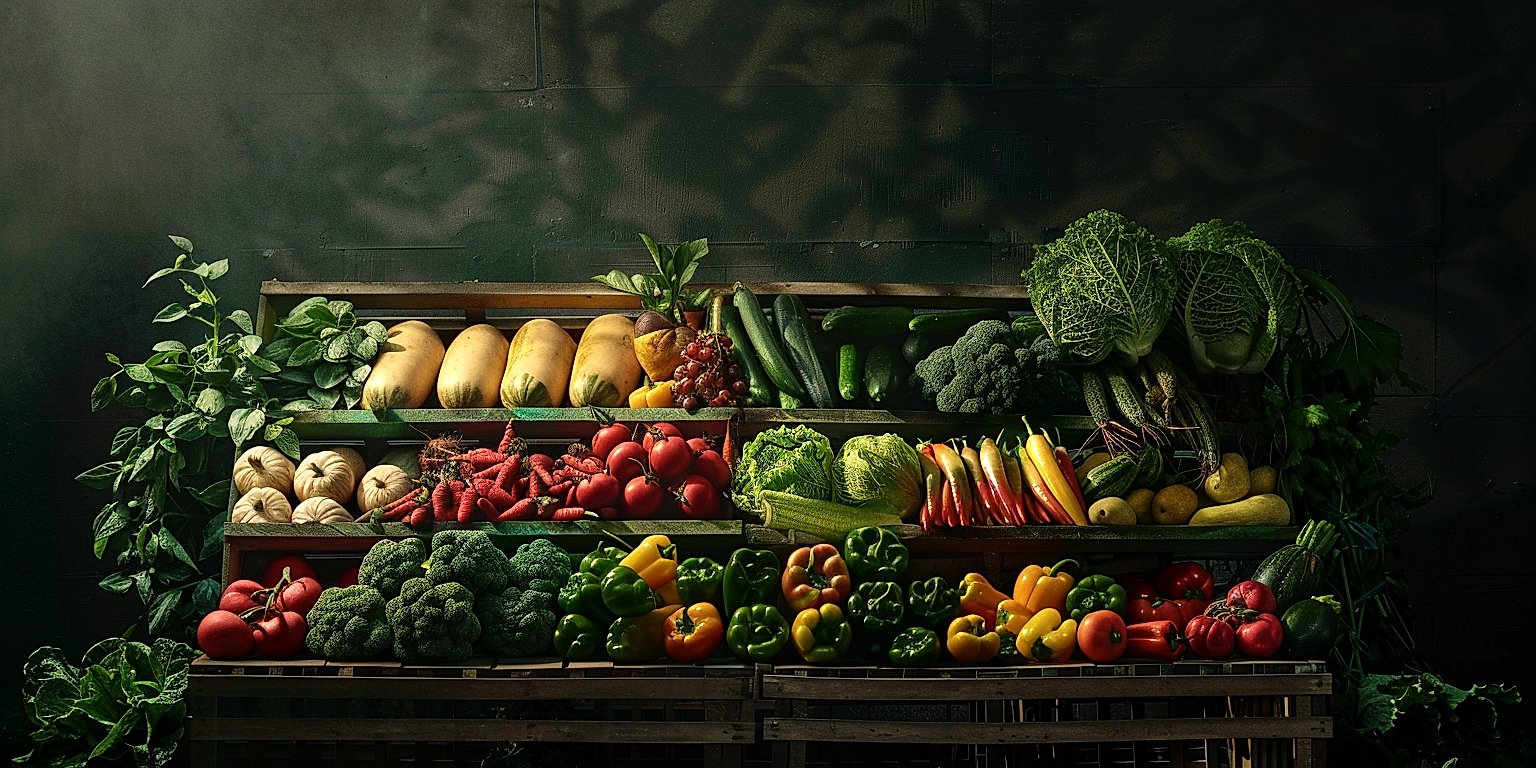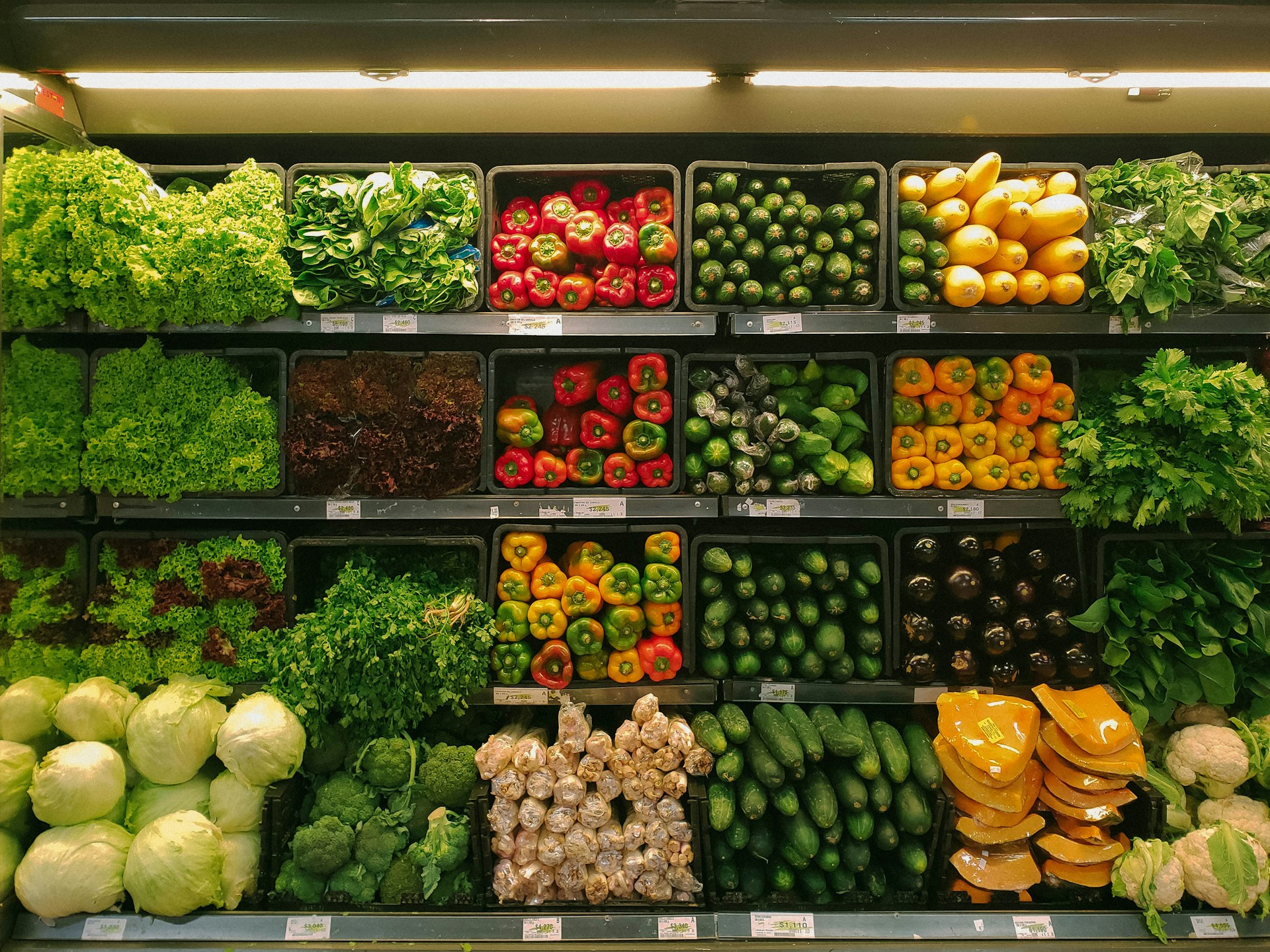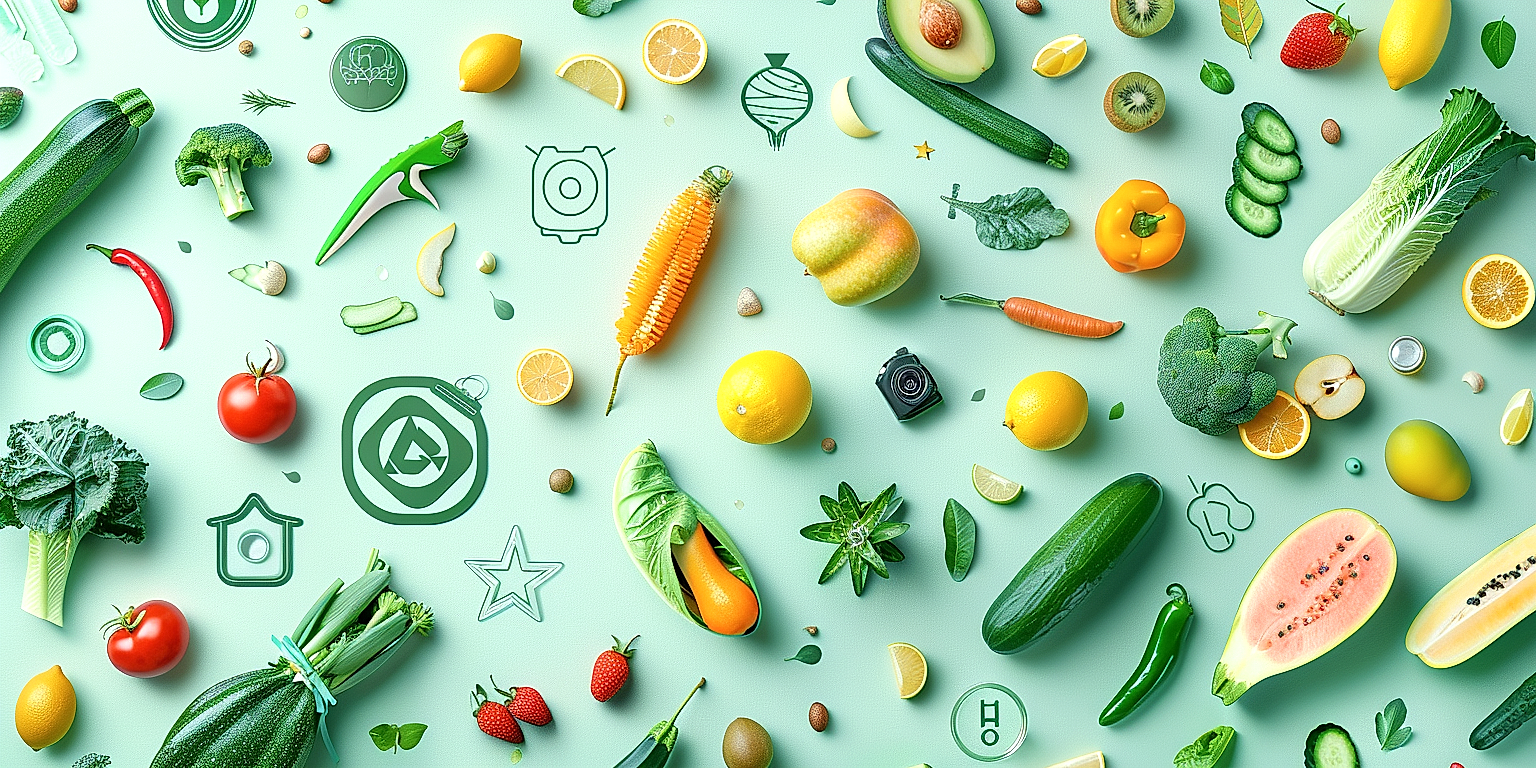Visual merchandising is a key element in successful retail branding strategies.
This pivotal tool can make items more appealing, leading to increased sales and brand recognition.
It is particularly significant in the field of produce retail where products are perishable and aesthetics play a crucial part in purchases.
Effective implementation goes beyond mere product arrangement.
This article aims to delve into the sophisticated intricacies of visual merchandising.
It offers insightful tactics specifically tailored for this sector, which could potentially revolutionize your retail branding approach.
Contents
- Visual Merchandising Techniques For Branding In Produce Retail
- 1. Use Bold Signage with Brand Logos and Colors
- 2. Display fresh produce artistically and creatively.
- 3. Use themed displays for holidays and events.
- 4. Highlight local or organic produce prominently.
- 5. Use well-lit, clean, and tidy display cases.
- 6. Incorporate multimedia content for product storytelling
- 7. Offer taste tests or cooking demonstrations.
- The Bottom Line
Visual Merchandising Techniques For Branding In Produce Retail
1. Use Bold Signage with Brand Logos and Colors
When establishing visual merchandising techniques in the produce retail industry, using bold signage with brand logos and colors is fundamentally important.
Brand logos and their associated colors play a vital role in brand recognition and are a cornerstone of a company’s visual identity.
It is therefore essential that these elements are prominently displayed in-store to encourage a connection between the customer and the brand.
With the use of bold signage, customers can easily identify a brand’s presence in a busy retail environment.
Signage should be consistent across all in-store marketing materials for a cohesive brand image.
This can include price tags, product descriptions, and informational signs about sales or promotions.
Manufacturing these signs in bold, attention-grabbing colors that align with the brand’s color scheme can further strengthen brand identity.
The strategic placement of these signs is also key; they must be placed at eye level where they are easily spotted by customers.
In addition to in-store signage, a brand’s logo and colors should also be integrated into their online presence.
This might include their website, social media pages, email newsletters, or any digital advertising.
By establishing a consistent brand image across both physical and digital spaces, a business can cement its brand identity in the minds of its customers.
This consistent branding strategy not only boosts brand recognition but also fosters customer loyalty and inspires confidence in the quality of the brand’s products.
Through the use of bold signage with brand logos and colors as a visual merchandising technique, businesses in the produce retail industry can create a strong and identifiable brand presence that resonates with customers.
Even on a fundamental level, the successful use of bold signage can be a significant factor in drawing customers into the store and influencing their purchasing decisions.
Overall, the strategic use of bold signage with brand logos and colors is a powerful tool for branding in the produce retail industry.
2. Display fresh produce artistically and creatively.
In the competitive world of retail, great emphasis is put on the presentation of products.
This holds particularly true when it comes to fresh produce, as the way fruits and vegetables are displayed can greatly impact buying behavior.
Indeed, a creative and artistic display might be the distinguishing factor between your store and others, enticing customers to not only make a purchase, but to choose to shop with you time and again.
One of the crucial aspects to consider is making sure your fruits and vegetables look fresh.
This can be done by frequently rotating the produce and ensuring it’s clean and free of blemishes.
Having a variety of colors on display also catches the eye and increases appeal.
A well-constructed and thoughtfully planned out display can stimulate the senses and evoke a sense of freshness and healthiness.
In addition to this, creating a design with your produce can also be a great way to attract attention.
Try to think outside the box and arrange your fruits and vegetables in such a way that it tells a story.
Perhaps organize them by season or group foods together that are used in popular dishes – creativity can go a long way.
It’s also important to think about convenience and accessibility for the customer, remember to keep high demand items at eye-level and bulk items at lower levels, this can also add to the aesthetic design.
Never underestimate the power of proper signage, use signs to highlight deals, promote local produce, or explain seasonal offerings.
The use of different textures and materials in your display can also create excitement and increase visual appeal.
If done correctly, a creative and artistic display can turn the simple act of buying produce into an experiential event.
Creating a well-designed and creative fresh produce display not only leads to increased sales but also helps reinforce your store’s brand and reputation.
Remember the customer’s experience and interaction in your store is also part of your brand the visual merchandising has to align with this as well.
3. Use themed displays for holidays and events.
Themed displays for holidays and events are a fantastic opportunity to attract customers and stimulate sales.
They capture the customer’s attention by offering a visual delight that is different from the usual store layout.
These displays can be crafted to tell a story or evoke a feeling associated with a particular event such as Christmas, Thanksgiving, or local harvest festivals.
Moreover, since most holidays and events involve some type of food, these themed displays can highlight the products you want to sell during that period.
For instance, during the holiday season, a display featuring winter produce alongside holiday staple items can be very effective.
Creating seasonal displays not only promotes certain products but also evokes emotions and associations that make shopping a pleasure rather than just another chore.
Through clever use of space, color, and composition, these themed displays can arouse customers’ interest.
Be sure to refresh these displays often to keep the store’s appearance new and exciting, which, in turn, encourages repeat visits.
However, purely decorative stuff should not overshadow the produce itself.
Every element in your display should serve a purpose – to enhance the product’s visibility or convey its freshness and quality.
Remember, the goal is to make the produce look so appealing that customers will want to buy it.
Also, displaying recipes, cooking tips, or pairing suggestions can additionally boost sales during holiday seasons.
While creating these displays, it is crucial to consider your brand’s overall image and ensure that your display aligns with it.
Last but not least, don’t forget to use this opportunity to cross-sell or up-sell – group products that can be used together or offer a discount when buying certain products in bulk.
Using themed displays for holidays and events is an interesting technique that not only enhances your store’s aesthetic appeal but also helps drive sales during specific periods.
4. Highlight local or organic produce prominently.
Emphasizing the local or organic produce prominently in your produce retail is a smart business strategy for a multitude of reasons.
This not only differentiates your shop from mainstream grocery chains, but also creates a positive image for your store in the eyes of increasingly-health conscious consumers.
A distinct, well-marked section for local or organic produce can act as a beacon for health-conscious shoppers, guiding them to the wholesome products they’re searching for.
There’s a growing trend of consumers being more interested in the origin of their food, their nutritional content, and the agricultural practices that were used in their production.
By displaying the local and organic produce at a prominent location, you capitalize on this trend and cater to this customer segment.
However, to correctly execute this merchandising technique, you should not just dump all the local or organic produce in one place.
Each piece of produce should be treated as an individual item, with its own distinct features to showcase and its own story to tell.
Visual aspects such as color, size, and shape of the produce should be considered when arranging these items.
Visual cues such as signage indicating the origin of the produce, the farm where they were grown, or the methods used in cultivation can build trust and foster a connection between you and your customers.
Demonstrating the journey of the produce from farm to fork makes customers feel involved and informed about what they are buying.
Additionally, using crates, baskets, or barrels to display local or organic products can emphasize the farm-to-table feel and amplify the appeal.
However, always remember to maintain the freshness and quality of the produce as they can dramatically impact the overall aesthetic, and therefore the effectiveness of your visual merchandising.
If needed, you can also partner with local farmers to offer exclusive or seasonal offerings, which will attract more customer attention and show that you’re dedicated to supporting local agriculture.
By carefully curating how you present local or organic produce, you not only boost sales but also foster customer loyalty, as you’re distinctly catering to their desire for fresh, healthy and sustainable options,
In conclusion, putting the spotlight on local or organic products using strong visual merchandising techniques is a strategic move that can yield rich dividends for your produce retail business.
5. Use well-lit, clean, and tidy display cases.
The attractiveness of your produce retail stall is significantly influenced by the presentation and condition of your display cases.
Produce should be featured in well-lit, clean, and neat display cases to catch the consumer’s attention and entice them to buy.
Nothing discourages a customer faster than unattractively displayed produce in a dimly lit, dirty or cluttered case.
> An attractive display case not only enhances shopper’s experience but also makes the produce appear more appealing.Lighting plays an essential role in visual merchandising as it influences how products and spaces are perceived.
Good lighting makes the colors of your fruits and vegetables pop and attract customers’ attention.
Lighting should cast a natural and flattering light on the produce to highlight its freshness and quality.
Besides, clean display cases generate trust in the quality of the produce being sold.
Customers tend to associate cleanliness with quality and safety, and a clean display case gives the impression that the produce is well cared for.
Sanitation should be a priority, as dirty cases can harbor bacteria and affect people’s health.
Ensuring cleanliness also includes wiping spills immediately to prevent produce from spoiling or staining.
Lastly, a tidy display case can make produce more accessible and easier to find for customers.
Organize the products in a way that customers can easily browse through and find what they need with minimal effort.
In this sense, regularly restocking and rearranging produce is essential to maintain a tidy and full-looking display case.
Remember, a well-lit, clean, and tidy display area creates a positive shopping experience, boosting brand image in the retail produce market.
6. Incorporate multimedia content for product storytelling
In the modern retail industry, incorporating multimedia content for product storytelling has become a pivotal strategy.
It is no longer enough to simply present a product on a shelf – customers are increasingly interested in the story behind the product.
This is particularly relevant when it comes to produce retail, where customers are keen to understand where their food comes from, how it was grown, and the people behind it.
Utilizing different forms of media – such as videos, images, and audio – is a powerful way to create an emotional connection between your customers and your produce.
Rich and engaging multimedia content can bring the journey of the produce ‘from farm to table’ to life, in turn enhancing the shopping experience and fostering greater brand loyalty.
You could use screens near your produce displays to show videos of farmers harvesting the products, explaining their farming processes, or even cooking demonstrations using the produce.
With this strategy, not only are you showing customers the authenticity and quality of your products, but you’re also subtly educating them on how they can use the produce in their own cooking.
Photographs can also be powerful storytelling tools, particularly when they showcase the real, unvarnished truth of the farming process.
A series of photographs documenting the growth of a piece of produce, from a tiny seed to a ripe fruit or vegetable, can evoke a sense of wonder and respect for the natural processes at work.
Digital signage can also be used as a platform to share audio clips of farmers or growers sharing their stories, further humanizing the product and making the buying process a more personal experience.
It’s important to be consistent with your messaging across all mediums to create a cohesive brand image.
For example, if your brand has a particular focus on organic or sustainable produce, this should be clear in all your multimedia content.
The use of technology for storytelling in retail does not have to be limited to screens or speakers near your produce displays.
With the increasing use of smartphones, you could also consider creating QR codes that customers can scan to access additional multimedia content – such as recipes, interviews with farmers, or interactive farm tours.
This approach can create a highly immersive and interactive shopping experience for customers, making them feel truly connected with your brand and your products.
Ultimately, the goal of using multimedia content for product storytelling in produce retail is to add depth and richness to the customer experience by amplifying the voices of growers, celebrating the journey of the produce, and demonstrating the brand’s commitment to quality and authenticity.
7. Offer taste tests or cooking demonstrations.
One unique and effective visual merchandising technique that can boost brand recognition in produce retail is offering taste tests or cooking demonstrations.
This method engages customers through a unique, sensory experience, highlighting the quality and flavor of the brand’s produce.
It’s vital that retailers choose impactful recipes for the demonstration, spotlighting the taste and versatility of the produce.
For example, a simple and delicious salad recipe could demonstrate the freshness and flavor of organic vegetables.
A live cooking demonstration can also serve as a great branding opportunity by letting the company’s chef or representative narrate the process.
Incorporating branded aprons, utensils, and other kitchenware into the demonstration ensures that the brand is continuously visible throughout the event.
Additionally, the cooking demonstration provides a more interactive experience for the customers, encouraging them to ask questions and learn more about the brand.
This open line of communication can help establish a meaningful connection between the brand and the customer.
Furthermore, offering complementary taste tests alongside cooking demonstrations can be a great way to instantly showcase the taste of your product and foster a sense of generosity about your brand.
At the end of the demonstration, retailers can offer attendees branded recipe cards — taking the brand visibility from the shop directly to the customers’ homes.
This act builds a sense of community around the brand, thereby making it memorable.
Moreover, by advertising these events on social media, retailers can increase brand awareness beyond the confines of their store.
Social media can also be used to share short clips of the demonstrations or photos of attendees trying out the product, offering an authentic endorsement of the brand.
Therefore, by nature of being interactive and experiential, taste tests and cooking demonstrations can be leveraged as powerful visual merchandising strategies to reinforce the brand message in the minds of the consumers.
Hence, offering taste tests and cooking demonstrations is not just a fun activity, it’s a powerful strategic tool for enhancing brand visibility and recognition.
The Bottom Line
Creating an appealing, effective and interactive sales environment can significantly enhance the consumer shopping experience and drive increase in sales.
Vibrant signage, showcasing fresh produce with an artistic touch, promoting local or organic products prominently, and themed presentations can create an inviting atmosphere that celebrates food.
Add to this a regimented approach to cleanliness, superb lighting, and multimedia storytelling about the products’ origins or usage, you create a rich, sensory shopping environment.
Additionally, by promoting active customer participation through taste tests or cooking demonstrations, shoppers are aligned more tightly with the brand, which increases the likelihood of them making a purchase, thereby driving significant revenue and growth.




